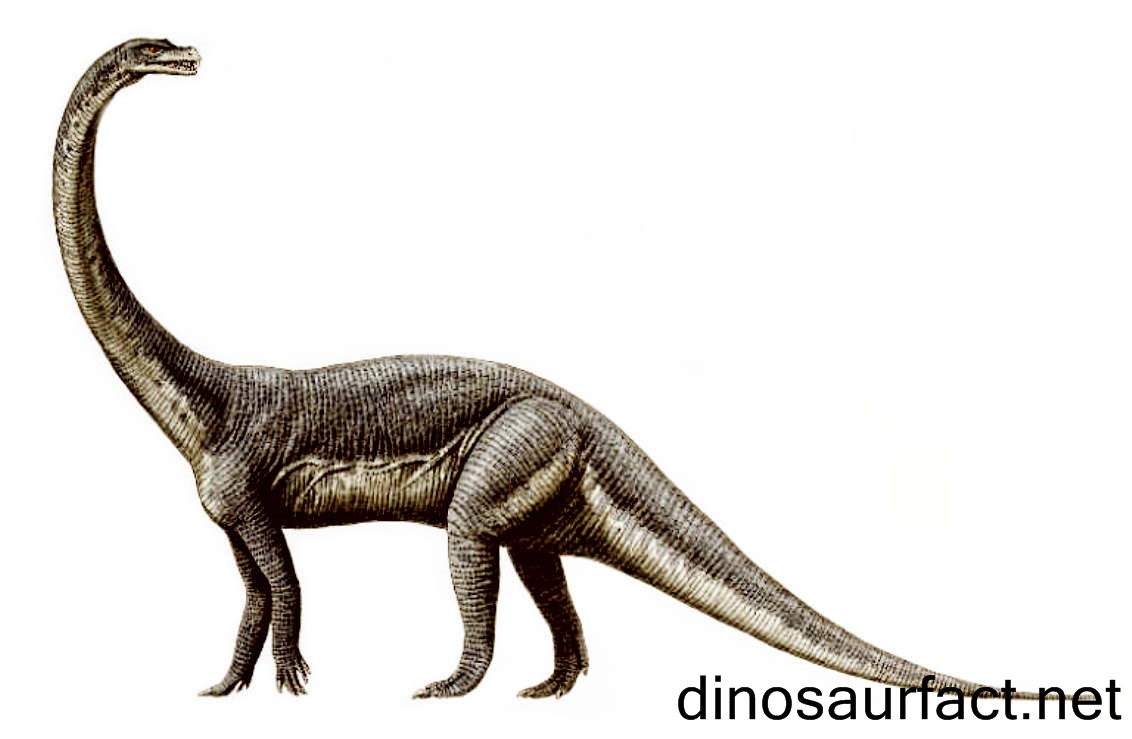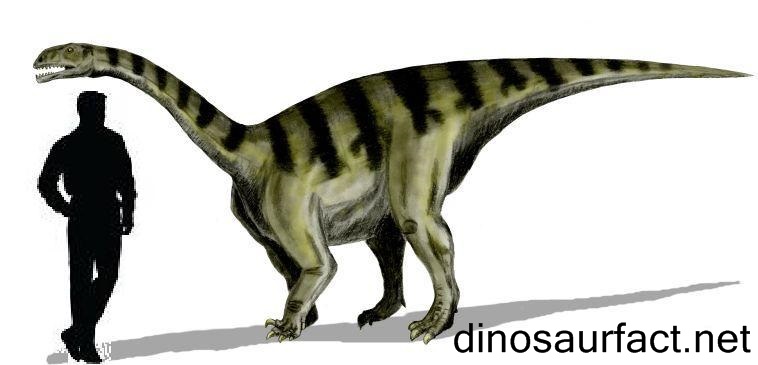 Click to visit the previous dinosaur bio
Click to visit the previous dinosaur bio
 |
|
 |
|
Kingdom: Animalia
Phylum: Chordata
Class: Sauropsida
Superorder: Dinosauria
Order: Saurischia
Suborder: Sauropodomorpha
Family: Plateosauridae
Genus: Euskelosaurus
 |
|
 |
|
 |
|

The Euskelosaurus was a massive prosauropod dinosaur. It was in existence in the late Triassic period about 220 to 205 million years ago. It was amongst the largest dinosaurs of its time. Its discovery played an important role in understanding the development of the gigantic sauropods of the Jurassic period.
The Euskelosaurus grew up to 30 to 35 meters in length and weighed about 1400 to 1600 kilos. These dimensions were much larger than other prosauropods. It was slow moving and most likely an herbivore.
The remains of the Skelosaurus have been discovered in the southern regions of the African continent. It is expected to have inhabited the whole of Africa in its heyday.
Nomenclature
The prefix 'eu' denotes good or better. The word ‘skelos’ has Greek origins. It translates to ‘hind legs from the hip below’. The word ‘os’ denotes the pelvis girdle. Thus the word ‘euskelos’ roughly translates to ‘having good legs.
The suffix ‘-saurus’ translates to ‘lizard’ in Latin. Thus the word ‘euskelosaurus’ means ‘a lizard with good legs’.
The specific name Euskelosaurus browni honors Alfred Brown who discovered the fossils. The name was suggested by paleontologist Thomas Huxley.
Classification
- The remains ascribed to the Euskelosaurus were christened ‘Euskelesaurus’ browni by Thomas Huxley in 1866. They were renamed ‘Euskelosaurus’ browni by Friedrich von Huene in the year 1902.
- The Euskelosaurus is defined only by a few bones of the extremities and some vertebrae. Based upon these, it is classified under order Saurishchia and sub order sauropodomorpha.
- The femur has provided information about its pelvic joint, indicating that it was a saurischian. The classification between ornithischians and saurischians is based upon the hip joint. The same bone has also afforded enough evidence to classify the Euskelosaurus as a sauropodomorph.
- Since prosauropods were generally much smaller than the Euskelosaurus, it was considered the intermediate species between prosauropods and the larger sauropods.
Discovery of fossils
Only a few fossils of the Euskelosaurus have been discovered till today. The only available fossils are fragments of the femur and occasional pieces of the spinal column.
The remains were discovered by an amateur fossil hunter Alfred Brown in 1863. They were found in the Lower Elliot Formation in southern Africa, in the Stromberg Mountains. Incidentely, Brown resided very close to the location of the discovery of the fossils. Another dinosaur, the Aliwalia, was also discovered in Brown’s hometown of Aliwal North.
Other fossils attributed to the Euskelosaurus were discovered in Lesotho and Zimbabwe.
The Elliot Formation and the Stromberg Mountains
The Elliot Formation is a natural rock formation encompassing southern Africa. It consists of stratified rocks.
The Elliot Formation is divided into two parts based on the composition of the rocks and their structure. These are called The Upper Elliot Formation and The Lower Elliot Formation.
The Elliot Formation has revealed the fossils of numerous theropod and sauropod dinosaurs, along with other flora and fauna of the Triassic period.
The Stromberg Mountains are located in the province of Eastern Cape in South Africa. They contain many coal beds and harvested regularly for extraction of fossil fuels.
Alfred Brown and Thomas H. Huxley
Alfred Brown was a dilettante fossil collector from South Africa who was well known for his endeavors. He discovered the fossils of the Euskelosaurus as well as the Aliwalia. Even prominent paleontologists have appreciated and acknowledged his contributions to the field of paleontology.
Thomas Henry Huxley was an English biologist and vertebrate paleontologist. He was very popularly known for supporting Charles Darwin’s theory of natural selection.
He completed his graduation from the University of London.
Huxley has made noteworthy contributions not only in the field of science but also in other fields such as literature and humanitarianism.
Physical features
The Euskelosaurus was very of a very large size as compared to the other dinosaurs present at that period of time. It was 9 to 12 feet in length from snout to tail. It weighed an impressive two tons.
The features that were characteristic of the Euskelosaurus were the long neck, sturdy limbs and a strong tail.
The Euskelosaurus was partially bipedal. It walked on all four legs bur it could support its weight on its hind legs in order to reach for vegetation at heights.
It had a slow gait. This was inferred by the size of its femur. Its legs, as strong as they were, were not meant for running.
Scientists have noted a strange property of its femur. It is twisted outwards along its shaft. Such a bone could probably indicate an adaptation for origins and inclusions of the massive thigh muscles. Or in the alternate it could imply that the dinosaur had a bow-legged structure of its hind legs.
Such a character is unusual for mammalians. If the Euskelosaurus did indeed have bent legs, it would be the first dinosaur to have been discovered with such a feature.
Habits and habitat
Most paleontologists concur that the Euskelosaurus was an herbivore. Its size and gait make carnivorous feeding habits unlikely.
Some scientists believe that the Euskelosaurus could have been an omnivore. Its predecessors were omnivores as were most prosauropods but this view is definitely in the minority.
The habitat of the Euskelosaurus consisted of wooded areas and light forests. Abundant water resources were also present in its environment.
Related species
It is believed that the Euskelosaurus is intimately related to the Riojasaurus and the Melanosaurus. The Riojasaurus was discovered in South America while the Melanosaurus in Africa. But both these continents were one single continent ‘Gondwana’ in the Triassic period.
The above mentioned dinosaurs are considered to be part of the species that gave rise to sauropods.
Final notes on the Euskelosaurus
The Euskelosaurus was one of the first dinosaurs discovered in Africa. It is considered an important link in understanding how the omnivorous and small prosauropods evolved in to the herbivorous and gigantic sauropods. The progression of bipedal dinosaurs to quadruped dinosaurs was also better understood after the discovery of the Euskelosaurus.
The fossil evidence about the creature is still very limited. If and when more fossils are discovered, the dominance of the sauropod dinosaurs in the Jurassic period will became a little less of a mystery.
Index
Extinct Profiles
 Triassic Dinosaurs
Triassic Dinosaurs Jurassic Dinosaurs
Jurassic Dinosaurs Cretaceous Dinosaurs
Cretaceous Dinosaurs Pterosaurs
Pterosaurs Marine Reptiles
Marine Reptiles Dinosaur Extinction
Dinosaur Extinction